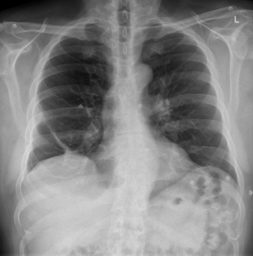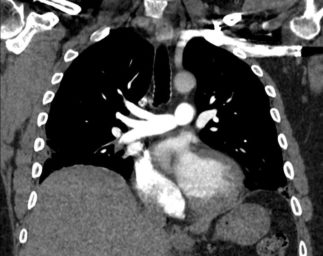Hampton hump
The Hampton hump is a well-defined pulmonary pleural based opacity representing haemorrhage and necrotic lung tissue in a region of pulmonary infarction caused by acute pulmonary embolism. The medial margin of the opacity frequently demonstrates a medial curved ‘hump‘ directed towards the heart.
The Westermark sign has a 22% sensitivity, 82% specificity, 29% PPV, and 76% NPV as reported by Worsley et al. (1993) based on the cohort from PIOPED (Prospective Investigation of Pulmonary Embolism Diagnosis).
The following radiological images are of a 34 year old male with a 6 day history of right sided pleuritic chest pain and shortness of breath. Chest x-ray and CTPA below
History
1940 – Hampton reviewed a series of 370 cases with autopsy-proven pulmonary embolism. He found that pulmonary infarction was found in nearly 70% of cases, and subsequent wall necrosis led to pulmonary haemorrhage and an organized scar. After 24-72 hours, alveolar wall necrosis and haemorrhage lead to pulmonary consolidation (the infarct/ hump), which often scars if blood supply remains poor and the patient does not succumb.
He found that in patients without heart disease, the area of infarction would generally heal without scarring, however, patients with congestive cardiac failure were more likely to progress to develop a persisting pulmonary scar.
Associated Persons
- Nils Westermark (1892 – 1980) [Westermark sign 1938]
- Aubrey Otis Hampton (1900 – 1955) [Hampton hump 1940]
- Felix George Fleischner (1893 – 1969) [Fleischner sign 1959]
- C. H. Joseph Chang (1929 – 2017) [Chang sign 1965]
- Antonio Palla (1950 – ) [Palla sign 1983]
Alternative names
- Hampton’s hump
References
- Hampton AO, Castleman B. Correlation of postmortem chest teleroentgenograms with autopsy findings with special reference to pulmonary embolism and infarction. American journal of roentgenology and radium therapy. 1940; 43: 305 –326. [Hampton Hump]
- Worsley DF, Alavi A, Aronchick JM, Chen JT, Greenspan RH, Ravin CE. Chest radiographic findings in patients with acute pulmonary embolism: observations from the PIOPED Study. Radiology. 1993 Oct;189(1):133-6.
- Marshall GB, Farnquist BA, MacGregor JH, Burrowes PW. Signs in thoracic imaging. J Thorac Imaging. 2006 Mar;21(1):76-90.
- Taylor BT, Pezzo SP, Rumbak M. Palla’s sign and Hampton’s hump in pulmonary embolism. Respiration. 2010;80(6):568
- Ladeiras-Lopes R et al. Hampton’s hump and Palla’s sign in pulmonary embolism. Circulation. 2013 May;127(18):1914-5.
- Patel UB, Ward TJ, Kadoch MA, Cham MD. Radiographic features of pulmonary embolism: Hampton’s hump. Postgraduate Medical Journal, 2014; 90(1065): 420–421.
- Miniati M, Bottai M, Ciccotosto C, Roberto L, Monti S. Predictors of Pulmonary Infarction. Medicine (Baltimore). 2015 Oct;94(41):e1488.
- Hsu CW, Su HY. Palla’s sign and Hampton’s hump in pulmonary embolism. QJM. 2017 Jan;110(1):49-50
- Cadogan M. CXR eponyms in pulmonary embolism. LITFL
eponymictionary
the names behind the name
Doctor in Australia. Keen interest in internal medicine, medical education, and medical history.


